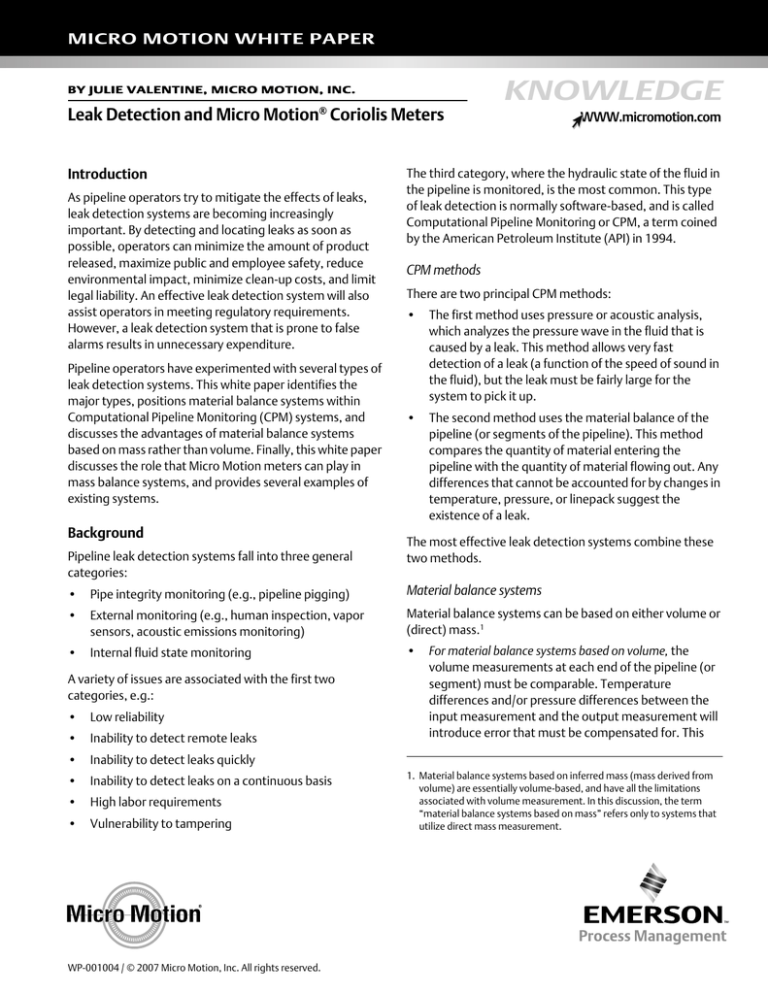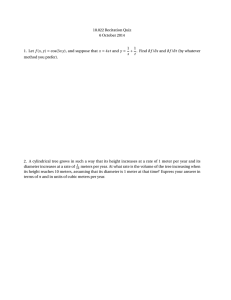
MICRO MOTION WHITE PAPER
BY JULIE VALENTINE, MICRO MOTION, INC.
Leak Detection and Micro Motion Coriolis Meters
®
Introduction
As pipeline operators try to mitigate the effects of leaks,
leak detection systems are becoming increasingly
important. By detecting and locating leaks as soon as
possible, operators can minimize the amount of product
released, maximize public and employee safety, reduce
environmental impact, minimize clean-up costs, and limit
legal liability. An effective leak detection system will also
assist operators in meeting regulatory requirements.
However, a leak detection system that is prone to false
alarms results in unnecessary expenditure.
Pipeline operators have experimented with several types of
leak detection systems. This white paper identifies the
major types, positions material balance systems within
Computational Pipeline Monitoring (CPM) systems, and
discusses the advantages of material balance systems
based on mass rather than volume. Finally, this white paper
discusses the role that Micro Motion meters can play in
mass balance systems, and provides several examples of
existing systems.
Background
Pipeline leak detection systems fall into three general
categories:
KNOWLEDGE
WWW.micromotion.com
The third category, where the hydraulic state of the fluid in
the pipeline is monitored, is the most common. This type
of leak detection is normally software-based, and is called
Computational Pipeline Monitoring or CPM, a term coined
by the American Petroleum Institute (API) in 1994.
CPM methods
There are two principal CPM methods:
•
The first method uses pressure or acoustic analysis,
which analyzes the pressure wave in the fluid that is
caused by a leak. This method allows very fast
detection of a leak (a function of the speed of sound in
the fluid), but the leak must be fairly large for the
system to pick it up.
•
The second method uses the material balance of the
pipeline (or segments of the pipeline). This method
compares the quantity of material entering the
pipeline with the quantity of material flowing out. Any
differences that cannot be accounted for by changes in
temperature, pressure, or linepack suggest the
existence of a leak.
The most effective leak detection systems combine these
two methods.
•
Pipe integrity monitoring (e.g., pipeline pigging)
Material balance systems
•
External monitoring (e.g., human inspection, vapor
sensors, acoustic emissions monitoring)
Material balance systems can be based on either volume or
(direct) mass.1
•
Internal fluid state monitoring
•
A variety of issues are associated with the first two
categories, e.g.:
•
Low reliability
•
Inability to detect remote leaks
•
Inability to detect leaks quickly
•
Inability to detect leaks on a continuous basis
•
High labor requirements
•
Vulnerability to tampering
WP-001004 / © 2007 Micro Motion, Inc. All rights reserved.
For material balance systems based on volume, the
volume measurements at each end of the pipeline (or
segment) must be comparable. Temperature
differences and/or pressure differences between the
input measurement and the output measurement will
introduce error that must be compensated for. This
1. Material balance systems based on inferred mass (mass derived from
volume) are essentially volume-based, and have all the limitations
associated with volume measurement. In this discussion, the term
“material balance systems based on mass” refers only to systems that
utilize direct mass measurement.
MICRO MOTION WHITE PAPER
requires measuring temperature and pressure at both
ends of the line, in addition to volume, and then
converting the volume measurement either to
“standard” conditions or to mass (the preferred
solution). However, if either temperature or pressure
varies significantly inside the pipeline, the end
measurements are not truly representative and the
applied compensation factors are not accurate.
Temperature compensation, in particular, can be
challenging if the pipeline is exposed to different
environments (e.g., if some segments are below
ground, under a body of water, etc.).
•
For material balance systems based on mass, because
mass measurements are not affected by temperature
or pressure, no temperature or pressure compensation
is required.
Accordingly, material balance systems based on mass
require less instrumentation, and because only one
measurement device is used, they are typically more
accurate.
However, a rigorous leak detection system, whether
volume-based and mass-based systems, will require
linepack compensation. Linepack compensation adjusts
measurements for the amount of material in the pipe.
Linepack compensation is implemented by the software
component of CPM systems, and is one of the primary
reasons that the software is required.
Page 2 of 6
Accordingly, all meters must be of custody transfer quality,
e.g.:
•
The meters must provide high-accuracy measurement.
•
All measurements must be repeatable through
changing process conditions (changing flow rates,
density, viscosity, etc.).
•
All measurements must be reliable and sustainable
over time.
Micro Motion offers an array of Coriolis meters that meet
these requirements. Various models are available with an
accuracy specification of 0.1%, and for the most rigorous
applications, the enhanced ELITE meter with an accuracy
specification of 0.05% can be used. Combining direct mass
measurement with high accuracy, these meters are the
ideal choice for leak detection applications.
In addition, Micro Motion Coriolis meters provide other
features that are useful in a leak detection system:
•
Because Coriolis meters measure density as well as
mass, the system can be used for secondary functions.
For example, the density measurement can be used to
monitor changes in process fluid composition, e.g., to
track batches of product as they pass multiple
metering stations, or to monitor product quality.
•
Because the Coriolis meter measures the density of the
entire flowing stream, independent of fluid
composition, it is more accurate for process fluids with
complex or variable composition than other
technologies that infer the density (e.g., using lookup
tables).
•
The meter verification feature, available with newer
Micro Motion meters, enables a quick online check of
meter performance. When variation between meters is
out of tolerance, operators can quickly rule out false
alarms or meter damage.
Requirements for an effective mass balance
system
Although a mass balance system is theoretically accurate,
its real-world accuracy depends on the accuracy of the
mass measurement devices and the linepack calculation.
Meter accuracy directly determines the system’s
sensitivity, or ability to detect small leaks. Furthermore, the
overall accuracy of the system is a function of the least
accurate meter.
Leak Detection and Micro Motion Coriolis Meters
This section presents four real-world situations in which
Micro Motion meters are used for leak detection.
Leak detection using flow reconciliation
A refiner in the eastern United States needed a leak
detection system to meet the pipeline monitoring
requirements established by the Department of
Transportation. The pipeline in question is 74 miles long
and 12 inches in diameter. It carries various Canadian crude
oils including sweet, sour, and heavy crudes.
The refiner chose to use flow reconciliation to meet DOT
requirements. Three metering stations were installed: one
at each end of the pipeline and one in the center. PD
meters were installed at each station. With constantly
changing environmental conditions and fluid properties,
the PD meters were not sufficiently accurate to meet
requirements. The refiner was unable to demonstrate to
authorities that there were no leaks currently in the
pipeline or that an effective leak detection system was in
place.
A project to improve the flow reconciliation was
undertaken. The refiner installed two D600 meters from
Micro Motion, one at each end of the pipeline, and mass
totals from these two meters were compared every hour:
•
If the totals matched within 0.7%, the pipeline was
assumed to be intact.
•
If the totals varied by more than 0.7%, an alarm was
generated.
The conversion to Micro Motion meters was immediately
successful, and the refiner was able to meet DOT
requirements.
However, when mass flow rates from the two meters were
compared on a continuous basis:
•
If pipeline operation was steady, the meters agreed to
within 0.1%.
•
If pipeline operation changed (e.g., a tank was
switched or a pump was shut down), the readings
would diverge until flow again reached steady state.
Figure 1 shows two examples of changes in pipeline
operation and the effects on measurement. In Figure 1, the
data lines represent mass flow rate from Meter 1 at the
tank farm (the pipeline entrance) and Meter 2 at the
pipeline exit. The meter readings are in close agreement
until Event 1 (a tank switch at the tank farm). The tank
switch registers only on Meter 1. When the disruption is
over, the meter readings again agree until Event 2 occurs (a
pump shutdown at the pipeline exit). Both meters register
this change, but at different times. Event 3 (pump restart)
is also registered by both meters but at different times.
Event 2
Barrels per day
Case studies
Page 3 of 6
Event 1
Event 3
Time
Figure 1. Flow data – Steady state vs. pipeline events
These results demonstrate the importance of linepack
compensation in leak detection systems. If only the hourly
reconciliation is used, it would be possible for a leak to go
undetected for up to an hour, but comparison of flowrate
data cannot distinguish between pipeline events and leaks
without the assistance of linepack compensation.
Leak detection using a four-meter voting system
A refiner based in Europe sends products from the refinery
to a tank farm located on the opposite bank of a large river.
The pipelines run below the riverbed, and local authorities
required a leak detection system to monitor for leaks into
the river.
The original system used a volume-based materials balance
system with both PD and turbine meters. This system
generated a large number of false alarms, so a new system
based on mass measurement was designed.
MICRO MOTION WHITE PAPER
Page 4 of 6
To increase statistical accuracy and reliability, four Micro
Motion meters were installed on each pipeline, two at each
end (see Figure 2). Mass flow data is reported to a central
station. If the four meters agree to within 0.5%, the pipeline
is assumed to be intact; if any one of the four meters is
outside this limit, an alarm is generated. Because of the
relatively short length of the pipeline, linepack
compensation was not needed.
The system was so successful that it has been implemented
on 18 pipelines in this site.
Figure 3. Micro Motion leak detection meters
in Kenai, Alaska
Leak detection on pipeline transporting multiple fluids
An 800 km pipeline in Canada transports C2+ (ethane and
higher hydrocarbons), condensate, and crude oil. Only a
mass-based Coriolis system can easily measure process
fluids of such varied composition. Other methods either
infer density from look-up tables or require a separate
density device.
Figure 2. Micro Motion meter in pipeline to tank farm across river
Leak detection with linepack compensation
The pipeline operator has installed Micro Motion Coriolis
meters (see Figure 4), and uses them for leak detection and
for custody transfer – the same meters support both
functions.
The state of Alaska has established some of the most
stringent pipeline leak detection requirements in the
United States, and possibly the world. All leak detection
systems are inspected, tested, and monitored by the state.
At one site, PD meters were installed at various points
along a large crude oil pipeline into a refinery. Although a
statistical pipeline monitoring system was in place, the
leaks were being masked by the noise of the PD meters.
The site was unable to pass the state audit.
When replaced by Micro Motion meters (see Figure 3), and
mass flow rather than volume flow was reported to the leak
detection software, the leak detection system reached the
required levels of effectiveness and received state
approval.
Figure 4. Micro Motion meters used for both leak detection
and custody transfer
Leak Detection and Micro Motion Coriolis Meters
Summary
The most effective leak detection systems utilize a
combination of a pressure or acoustic analysis system and a
material balance system. The most accurate, reliable, and
robust material balance systems are based on mass, rather
than volume, and incorporate linepack compensation.
Coriolis meters from Micro Motion measure mass
accurately and reliably across changing process and
environmental conditions, with no requirement for
external temperature, pressure, or density data. Using leak
detection systems that include Micro Motion meters,
pipeline operators can detect leaks effectively with a
minimum of false alarms. Coriolis meters from Micro
Motion also support a variety of secondary functions such
as process fluid monitoring or custody transfer.
About the author
Julie Valentine is the Refining Industry Marketing Manager
for Micro Motion, Inc., in Boulder, Colorado. Julie is a
graduate of the Colorado School of Mines in Golden,
Colorado with a B.S. degree in Chemical and Petroleum
Refining Engineering. She spent eight years with UOP,
primarily in the Technical Services Group, where she was
involved in the commissioning, start-up, and
troubleshooting of UOP process units around the world.
Julie joined Micro Motion twelve years ago and now focuses
on how and where to apply Micro Motion's Coriolis
technology in the refining industry.
Page 5 of 6
MICRO MOTION WHITE PAPER
Page 6 of 6
Leak Detection and Micro Motion Coriolis Meters
WWW.micromotion.com
Micro Motion supports PlantWeb® field-based architecture, a
scalable way to use open and interoperable devices and systems
to build process solutions of the future.
ELITE, ProLink, and the Micro Motion logo are registered trademarks, and MVD and
MVD Direct Connect are trademarks of Micro Motion, Inc., Boulder, Colorado. The
Emerson logo is a trademark of Emerson Electric Co. All other trademarks are
property of their respective owners.
Micro Motion, Inc. USA
Worldwide Headquarters
7070 Winchester Circle
Boulder, CO 80301
T (303) 527-5200
(800) 522-6277
F (303) 530-8459
Micro Motion Europe
Emerson Process Management
Neonstraat 1
6718 WX Ede
The Netherlands
T +31 (0) 318 495 555
F +31 (0) 318 495 556
Micro Motion supplies this publication for informational purposes only. While every
effort has been made to ensure accuracy, this publication is not intended to make
performance claims or process recommendations. Micro Motion does not warrant,
guarantee, or assume any legal liability for the accuracy, completeness, timeliness,
reliability, or usefulness of any information, product, or process described herein. For
actual product information and recommendations, please contact your local
Micro Motion representative.
Micro Motion Japan
Emerson Process Management
1-2-5, Higashi Shinagawa
Shinagawa-ku
Tokyo 140-0002 Japan
T +81 3 5769-6803
F +81 3 5769-6844
Micro Motion Asia
Emerson Process Management
1 Pandan Crescent
Singapore 128461
T +65 6 777-8211
F +65 6 770-8003


